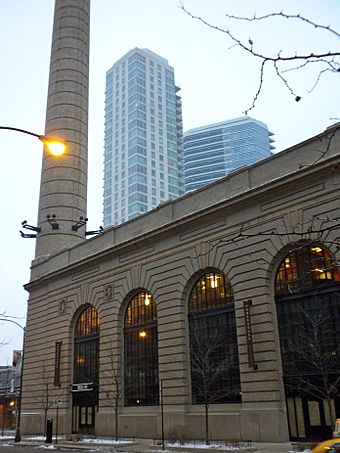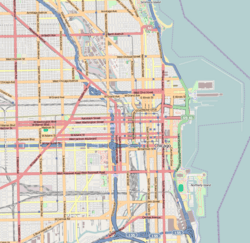Chicago and North Western Railway Power House facts for kids
|
Chicago and North Western Railway Power House
|
|
 |
|
| Location | 211 N. Clinton St., Chicago, Illinois |
|---|---|
| Area | less than one acre |
| Built | 1911 |
| Architect | Frost & Granger |
| Architectural style | Beaux Arts, Renaissance |
| NRHP reference No. | 04001306 |
Quick facts for kids Significant dates |
|
| Added to NRHP | December 10, 2004 |
The Chicago and North Western Railway Power House is a historic building in Chicago, Illinois. It used to be a special power station. This station provided electricity for the Chicago and North Western Terminal, a big train station that opened in 1911.
The building was designed by architects Frost & Granger in 1909. It looks very grand because it was built in the Beaux Arts style. It also has parts that look like Italian Renaissance Revival buildings.
Contents
What Was the Power House For?
This power house was finished in 1911, the same year the train station opened. It is shaped a bit unusually. It sits near Clinton Street, Milwaukee Avenue, Lake Street, and the old train tracks. Today, these tracks are used by Metra trains.
The building is made of light-colored brick, called cream brick. It has fancy decorations and edges made of terra cotta. A tall brick smokestack, about 227 feet high, stands at one corner. Inside, the building had four main rooms. There was a large engine room and a big boiler room. There was also a smaller office for the engineer and a reception room.
In 1948, a newspaper called the Chicago Tribune said something amazing. They reported that this power house made enough electricity for a city of 15,000 people! That's a lot of power for one building.
A Building That Survived
The power house stopped providing electricity to the train station in the 1960s. Later, in 1984, the original Chicago and North Western Terminal was torn down. A new station, the Ogilvie Transportation Center, was built in its place. Even though the main station was gone, the power house survived!
This building is very special. It is one of only two old railroad power houses left in Chicago. It is also the only one remaining from the Chicago and North Western Railway.
Becoming a Landmark
Because of its history and unique design, the power house became a protected building.
- On December 10, 2004, it was added to the National Register of Historic Places. This is a list of important historic places in the United States.
- Then, on January 11, 2006, it was named a Chicago Landmark. This means it's a very important building for the city of Chicago.
A New Life for the Power House
Before it became a landmark, people thought the building might be torn down. It even had some damage in 1992 from the Chicago Flood. But a company that develops real estate bought the building. They decided to give it a new purpose.
They added two new floors inside the building. Then, they turned it into a modern office and retail space. This means it now has offices and shops. In 2007, these changes won an award called the "Best Adaptive Reuse award" from Landmarks Illinois. This award celebrates projects that give old buildings a new life.




